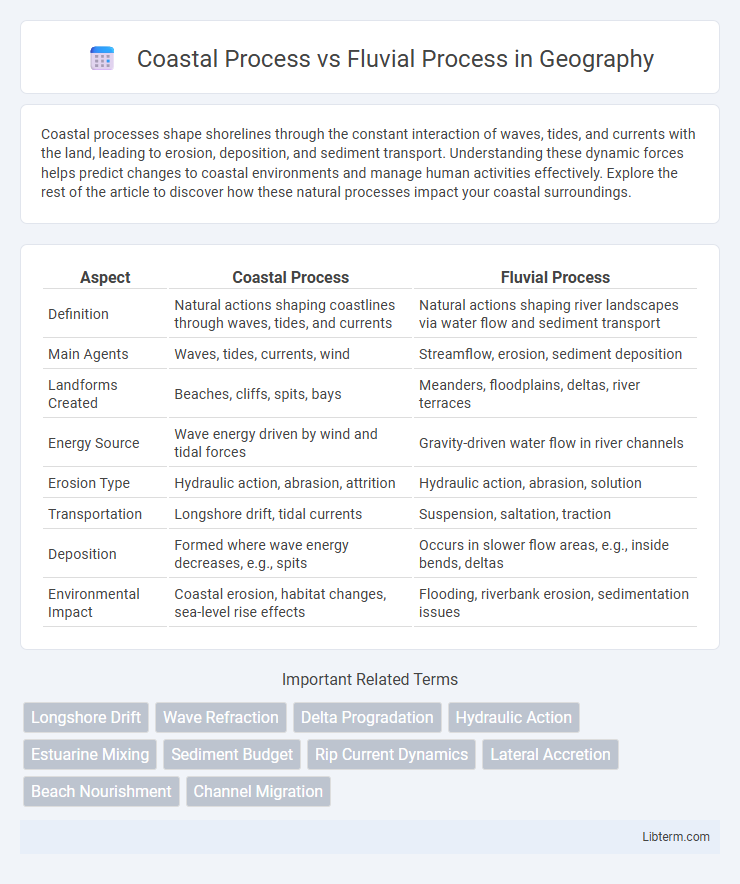Coastal processes shape shorelines through the constant interaction of waves, tides, and currents with the land, leading to erosion, deposition, and sediment transport. Understanding these dynamic forces helps predict changes to coastal environments and manage human activities effectively. Explore the rest of the article to discover how these natural processes impact your coastal surroundings.
Table of Comparison
| Aspect | Coastal Process | Fluvial Process |
|---|---|---|
| Definition | Natural actions shaping coastlines through waves, tides, and currents | Natural actions shaping river landscapes via water flow and sediment transport |
| Main Agents | Waves, tides, currents, wind | Streamflow, erosion, sediment deposition |
| Landforms Created | Beaches, cliffs, spits, bays | Meanders, floodplains, deltas, river terraces |
| Energy Source | Wave energy driven by wind and tidal forces | Gravity-driven water flow in river channels |
| Erosion Type | Hydraulic action, abrasion, attrition | Hydraulic action, abrasion, solution |
| Transportation | Longshore drift, tidal currents | Suspension, saltation, traction |
| Deposition | Formed where wave energy decreases, e.g., spits | Occurs in slower flow areas, e.g., inside bends, deltas |
| Environmental Impact | Coastal erosion, habitat changes, sea-level rise effects | Flooding, riverbank erosion, sedimentation issues |
Introduction to Coastal and Fluvial Processes
Coastal processes involve the dynamic interactions between ocean waves, tides, and currents shaping shorelines through erosion, transportation, and deposition of sediments. Fluvial processes refer to the movement of water and sediment in river systems, influencing landscape formation through erosion, sediment transport, and deposition along riverbanks and floodplains. Both processes are critical in geomorphology, with coastal processes primarily driven by marine forces and fluvial processes dominated by riverine hydrodynamics.
Definition of Coastal Processes
Coastal processes refer to the dynamic natural mechanisms such as wave action, tidal currents, and sediment transport that shape and modify shorelines. These processes influence the formation of coastal features like beaches, cliffs, and estuaries by redistributing sediments along the coast. Unlike fluvial processes, which primarily involve river erosion and deposition, coastal processes are driven by marine forces acting at the land-sea interface.
Definition of Fluvial Processes
Fluvial processes refer to the movement and action of rivers and streams in shaping the landscape through erosion, transportation, and deposition of sediments. These processes influence the formation of valleys, floodplains, and riverine landforms by continuously altering the Earth's surface. Understanding fluvial dynamics is essential for managing water resources and predicting sediment behavior in river basins.
Key Agents Driving Coastal Processes
Waves, tides, and currents serve as the primary agents driving coastal processes, shaping shorelines through erosion, transportation, and deposition of sediments. Wind-generated waves continuously exert energy on the coast, influencing beach morphology and sediment distribution. Tidal forces contribute to the regular rise and fall of sea levels, affecting intertidal zones and influencing sediment dynamics along coastal environments.
Key Agents Driving Fluvial Processes
Key agents driving fluvial processes include water flow, sediment load, and gradient, which together influence erosion, transportation, and deposition in river systems. Fluvial processes are characterized by the dynamic movement of water that shapes valleys and floodplains, contrasting with coastal processes driven primarily by wave action, tides, and currents. Understanding the impact of discharge variability and sediment supply is essential to analyzing river morphology and landscape changes.
Major Landforms Shaped by Coastal Processes
Major landforms shaped by coastal processes include beaches, spits, barrier islands, and sea cliffs, formed primarily through wave action, tides, and coastal erosion. Coastal deposition creates features like sand dunes and estuaries, where sediment accumulates due to the interaction of marine and terrestrial forces. Unlike fluvial processes dominated by river erosion and sediment transport forming valleys and deltas, coastal processes sculpt dynamic shorelines influenced by marine energy and sea-level changes.
Major Landforms Shaped by Fluvial Processes
Rivers sculpt major landforms such as valleys, floodplains, deltas, and alluvial fans through processes of erosion, transportation, and deposition. Meanders form as the river erodes laterally, creating winding valleys, while deltas accumulate sediment at river mouths where flow velocity decreases. Floodplains develop from regular overflow events, depositing nutrient-rich sediments that shape fertile landscapes essential for agriculture.
Comparison: Erosion and Deposition in Coastal vs Fluvial Systems
Coastal processes involve erosion primarily through wave action, tidal currents, and longshore drift, resulting in distinctive features such as cliffs, wave-cut platforms, and beaches formed by sediment deposition. Fluvial processes focus on river-driven erosion and deposition, where hydraulic action and abrasion shape valleys and floodplains, while sediment accumulation creates deltas and alluvial fans. The key difference lies in energy dynamics: coastal systems experience dynamic, cyclic wave energy causing rapid sediment transport, whereas fluvial systems have variable flow rates influencing sediment sorting and channel morphology over time.
Human Impacts on Coastal and Fluvial Processes
Human activities significantly alter coastal processes through construction of seawalls, groynes, and jetties, which disrupt natural sediment transport and lead to increased erosion or accretion in adjacent areas. In fluvial systems, dam construction, river channelization, and deforestation modify flow regimes, sediment load, and deposition patterns, causing habitat loss and increased flood risk. Urbanization and agricultural practices further exacerbate these impacts by increasing surface runoff and pollution, ultimately affecting the dynamic equilibrium of both coastal and fluvial environments.
Coastal and Fluvial Process Interactions and Environmental Implications
Coastal and fluvial processes interact dynamically where rivers meet the sea, influencing sediment transport, delta formation, and shoreline morphology. These interactions shape estuarine ecosystems, affect nutrient distribution, and impact coastal erosion and flooding patterns. Understanding the combined effects of tidal forces and river discharge is crucial for managing coastal resilience and mitigating environmental risks.
Coastal Process Infographic

 libterm.com
libterm.com